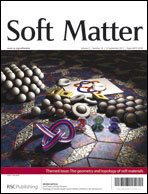Elementary building blocks of nematic disclination networks in densely packed 3D colloidal lattices
Abstract
Nematic liquid crystals in frustrated environments are known to form a variety of topological defect conformations – possibly networks – with multiple meta-stable states of the nematic order. Here, we study the defect networks and their reconfigurability in a periodically spatially frustrated nematic, focusing specifically on the network formed in the nematic-filled voids of opal-like closely packed face centred cubic colloidal crystals. Using spherical colloidal particles with homeotropic anchoring, the liquid crystal fills a network of interconnected cavities with complicated surface-imposed conditions, generating a complex defect network of −1/2-winding number disclinations. We show that this network can be decomposed into a network of cubic and tetrahedral nematic elements, allowing us to enumerate the possible network conformations and use topological methods for their characterisation. We use combinatorics and geometry to predict all the possible conformations, their topology, and their free energy. The predictions are completely confirmed with numerical simulations. More generally, the presented results demonstrate an analytic approach towards achieving exactly addressable memory states in soft matter composite materials.

- This article is part of the themed collection: The geometry and topology of soft materials

 Please wait while we load your content...
Please wait while we load your content...